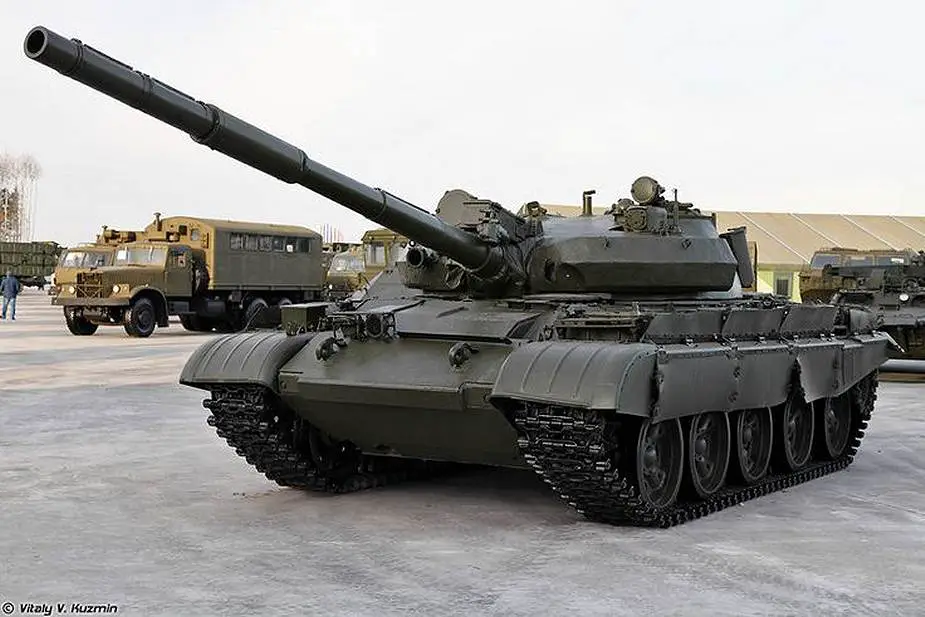Analysis: Russian T-62M tanks have significant advantages
Military Watch magazine has highly assessed the prospects for using the modernized T-62M tank, which was on display at the Army 2022 international military-technical forum. The magazine believes that Western sources are too pessimistic in assessing the causes and consequences of such modernization and supposes that the upgraded armored vehicle could take part in the war in Ukraine.
Follow Army Recognition on Google News at this link

T-62M (Picture source: Vitaly Kuzmin)
The T-62 main battle tank was produced from 1962 to 1975 by enterprises that today are part of Russia’s Uralvagonzavod Group (UVZ, part of the Rostec state hi-tech corporation). In all, about 20,000 T-62 tanks were manufactured.
“The T-62 first entered service in 1961 and was widely assessed to be the most capable tank in the world at the time including by U.S. and Israeli experts who analyzed captured units after the 1973 Yom Kippur War,” the article reads. “The tank was the first tank in the world with a smoothbore gun and armor piercing fin stabilizing discarding sabot (APFSDS) rounds, and demonstrated comfortable superiority over U.S. and British supplied M60 and Chieftain tanks during the Iran-Iraq War as attested to by officers from both sides.”
In 1983, the armored vehicles started to undergo heavy upgrades to the T-62M (M1/MV) level. During the modernization, additional armor protection of the turret, hull and bottom, slat armor, as well as the Tucha smoke grenade launcher and the Soda anti-napalm system were installed.
The upgraded version of the tank, the T-62M, equipped with a multispectral gyro-stabilized optoelectronic system with a thermal imager was unveiled at the Army 2022 forum. The multispectral gyro-stabilized optoelectronic system was mounted on the tank turret with a mast.
As a spokesman for the Defense Ministry told TASS, the system was developed by the Tsiklon Central Research Institute. “It detects targets visually, and it has thermal imaging channels and a rangefinder. Now drone counteraction is relevant. A high-resolution camera looks for them, detects, locks on and tracks them,” he said.
“That is, he gets up, raises the mast somewhere in the forest and observes what is happening there,” a spokesman for the Defense Ministry’s Main Automotive-Armored Directorate said.
Adequate to current threats
“Although old by 21st century standards, modernized T-62s have a number of significant advantages over newer T-72 and T-90 tanks that form the backbone of Russian frontline armor, which could explain why Russia is investing in enhancing these vehicles despite having very large quantities of T-72s in its reserves,” the article reads.
According to the media outlet, the T-62 is prized for its much lower maintenance requirements and operational costs, and is also straightforward to train on allowing new personnel to learn to operate the vehicles relatively quickly.
The author of the article notes the successful use of T-62M tanks by the Syrian army and believes that modernized T-62s could be used to equip not only reservists called up under the partial modernization campaign, but also units from Eastern Ukrainian regions that have recently joined the Russian Federation — the militia forces of which have still not been fully integrated into the Russian Army.
“Ukraine’s lack of modern tanks and reliance on 1970s T-64 variants with few enhancements means that enhanced T-62s will not be outmatched by enemy armor, particularly considering NATO members' reluctance to furnish Kiev with more modern armor,” the article reads.
T-62s modernized with Kontakt-5 or Relikt explosive reactive armor, latest-generation thermal sights, and possibly even new APFSDS rounds, among other new subsystems, could have very significant performance advantages over unmodernized T-72s, the Military Watch expert believes.
According to the media outlet, “although some Western sources have claimed that modernization and reactivation of T-62s is a result of desperation following Western sanctions on the Russian defense sector, the technologies such as thermal sights most vulnerable to sanctions are precisely those which will be enhancing the vehicles to a 21st century standard. If sanctions were the primary issue, it would be much easier for Russia to reactivate T-72s and T-80s from reserves than to modernize and reactivate its T-62s, meaning such a narrative holds little weight.”
Military Watch magazine cites some sources speculating that over 500 and possibly close to 1,000 tanks could be modernized. According to the article, the tank is a potentially useful asset that could be inexpensive to field in large numbers and relatively cheap to modernize.
Defense News October 2022


























